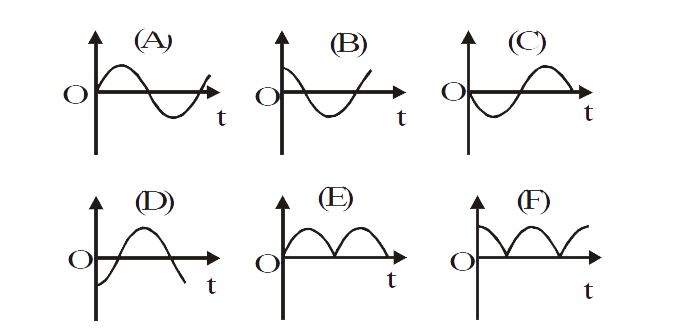Whatis the displacement equation of S.H.M. with an amplitude 2m , if 120 oscillations are performed during one minute and initial phase is 60∘ [ Consider displacement time equation of the form y=Asin(ωt+ϕ)] ?
2sin(4πt+π3)
2sin(4πt)
2sin(2πtπ3)
2sin(πt+π3)
The correct Answer is:1
To find the displacement equation of Simple Harmonic Motion (S.H.M.) given the amplitude, number of oscillations, and initial phase, we can follow these steps:
Step 1: Identify the given parameters
- Amplitude (A) = 2 m
- Number of oscillations = 120 in 1 minute
- Initial phase (φ) = 60° = π/3 radians (since we need to convert degrees to radians)
Step 2: Convert the time period from minutes to seconds
Since 1 minute = 60 seconds, we have:
- Time (T) = 60 seconds
Step 3: Calculate the frequency (f)
The frequency (f) is the number of oscillations per second. Given that there are 120 oscillations in 60 seconds:
f=120 oscillations60 seconds=2 Hz
Step 4: Calculate the angular frequency (ω)
The angular frequency (ω) is related to the frequency by the formula:
ω=2πf
Substituting the value of f:
ω=2π×2=4π rad/s
Step 5: Write the displacement equation
The standard form of the displacement equation for S.H.M. is:
y(t)=Asin(ωt+ϕ)
Substituting the values of A, ω, and φ:
y(t)=2sin(4πt+π3)
Final Displacement Equation
Thus, the displacement equation of the S.H.M. is:
y(t)=2sin(4πt+π3)
- Amplitude (A) = 2 m
- Number of oscillations = 120 in 1 minute
- Initial phase (φ) = 60° = π/3 radians (since we need to convert degrees to radians)
Since 1 minute = 60 seconds, we have:
- Time (T) = 60 seconds
The frequency (f) is the number of oscillations per second. Given that there are 120 oscillations in 60 seconds:
f=120 oscillations60 seconds=2 Hz
The angular frequency (ω) is related to the frequency by the formula:
ω=2πf
Substituting the value of f:
ω=2π×2=4π rad/s
The standard form of the displacement equation for S.H.M. is:
y(t)=Asin(ωt+ϕ)
Substituting the values of A, ω, and φ:
y(t)=2sin(4πt+π3)
Thus, the displacement equation of the S.H.M. is:
y(t)=2sin(4πt+π3)
Topper's Solved these Questions
- BOOK - AAKASH INSTITUTECHAPTER - OSCILLATIONSEXERCISE - ASSIGNMENT ( SECTION-C )11videos
OSCILLATIONS
- BOOK - AAKASH INSTITUTECHAPTER - OSCILLATIONSEXERCISE - ASSIGNMENT (SECTION -D( Comprehension) )1videos
OSCILLATIONS
- BOOK - AAKASH INSTITUTECHAPTER - OSCILLATIONSEXERCISE - ASSIGNMENT ( SECTION -A)58videos
OSCILLATIONS
- BOOK - AAKASH INSTITUTECHAPTER - NUCLEIEXERCISE - ASSIGNMENT (SECTION-D)10videos
NUCLEI
- BOOK - AAKASH INSTITUTECHAPTER - PHYSICAL WORLDEXERCISE - ASSIGNMENT (Section-B)5videos
PHYSICAL WORLD
Similar Questions
Knowledge Check
- Question 1 - Select One
The equation of S.H.M. with amplitude 4m and time period 1/2 s with initial phase π/3 is x =
A4sin(2πt+π/3)mB4sin(4πt+π/3)mC4sin(πt+π/3)mD4sin(2πt+π/6)m - Question 2 - Select One
The displacement of a particle in S.H.M. in one time period is
AAB2AC4ADZero - Question 3 - Select One
The displacement of a particle is represented by the equation y=sin2ωt the motion is
Anon - periodicBperiodic but not simple harmonicCsimple harmonic with period 2π/ωDsimple harmonic with period π/ω
The displacement of a particle in S.H.M. is x=asinωt. Which of the following graph between displacement and time is correct :
 View Solution
View SolutionThe displacement equation of an oscillator is given by x = 5 sin (2πt+0.5π)m. Then its time period and initial displacement are
View SolutionThe equation of S.H.M. isy=asin(2πnt+a), then its phase at time t is
View SolutionGiven equation of S.H.M. is y = 10 sin(20t+0.5). The initial phase is
View SolutionThe displacement equation of a simple harmonic oscillator is given by y=Asinωt−Bcosωt
The amplitude of the oscillator will beView Solution

